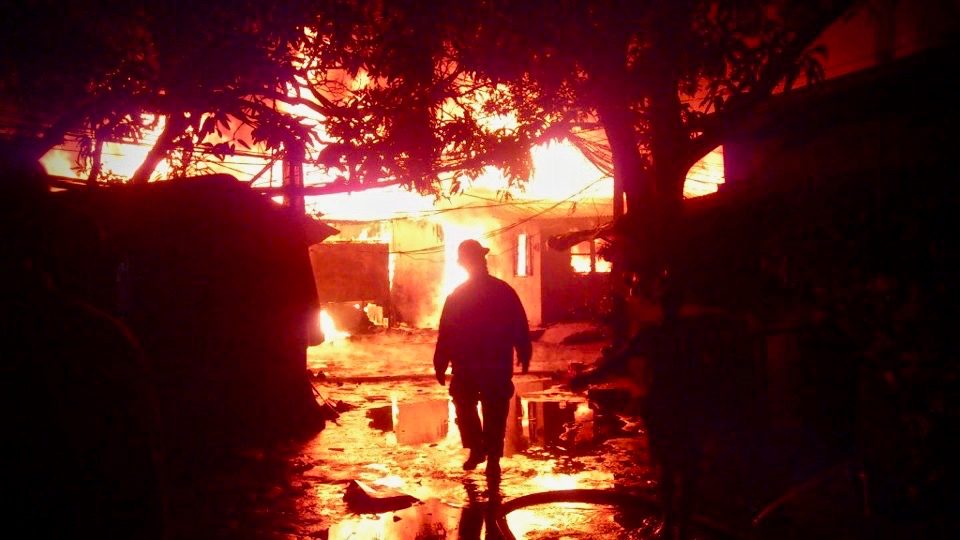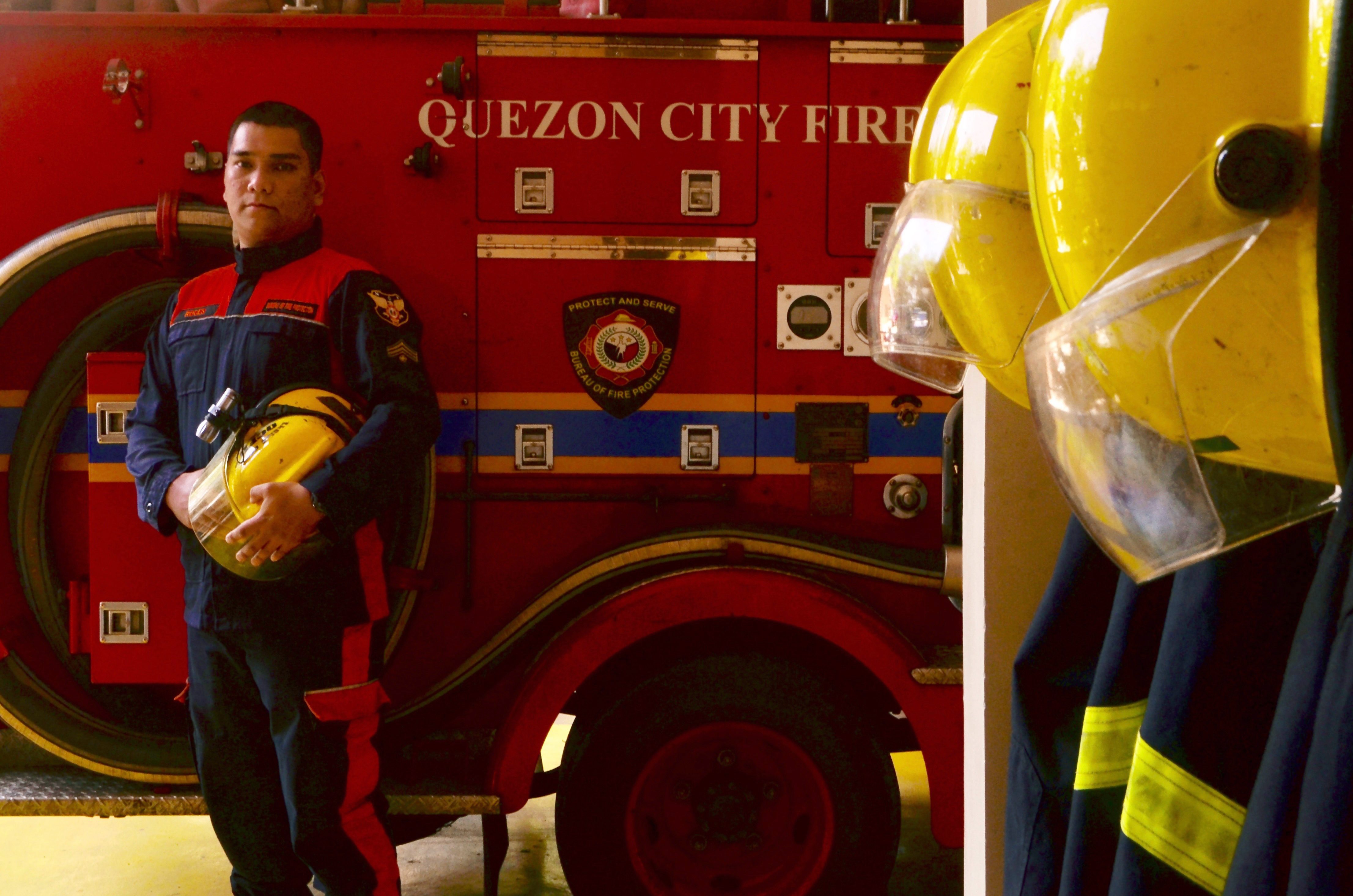SUMMARY
This is AI generated summarization, which may have errors. For context, always refer to the full article.

MANILA, Philippines – The men and women of the Quezon City Fire District are not afraid of fire. It is an element they have learned to tame through time.
Nurses, engineers, teachers, and police officers by profession, part of their passion is preventing, if not killing fires.
March is the month when they do the most battles with fire. Undermanned and with inadequate essential equipment, they go about doing their jobs as best they can.
Deputy Fire Marshall Noel Gagalac prays each time a team from his station runs to an incident, hoping every fire officer who rushes out of his or her headquarters comes back safe.
Having been in the Bureau of Fire Protection since 1991, he is familiar with the stress his officers are exposed to. On top of fighting fires, they conduct building inspections, facilitate fire prevention seminars, respond to road accidents, and during the monsoon season, face floods.
From his administrative position, he sees what’s above their limitations: his station lacks fighters and his fighters lack arms.

“Until now, we have not filled the lack in manpower and equipment,” Gagalac told Rappler.
The Housing and Land Use Regulatory Board set the ideal standard – for every 20,000 residents, there has to be at least one firefighter.
This means Quezon City, a city of 2.94 million people, needs at least 1,470 fire officers, but the Quezon City Fire District has only 398. For fire trucks, Quezon City needs 105; the city has only 33.
With this, the firefighters are forced to make do with what they have.
No air, only courage

It was dawn when Richard Roces heard the radio blast that a house was burning 4 blocks away from their family home in Sampaloc.
He immediately wore his volunteer uniform, packed his protective gear, and rode his scooter to the scene, just as the sun was rising. By noon, he had rescued his first life, carrying out a man from a burning house, before the other firefighters came.
He was 17 then.
Now 28, Richard Roces is already a licensed nurse and has been a firefighter since 2011.
Even with his experience, he still fears for his life due to the lack of equipment. He boldly goes inside burning houses as he has always done, but instead of wearing a breathing apparatus in the melting heat, he just holds his breath.
“Hold your breath at lakas lang ng loob (Hold your breath and be daring),” he would repeat to himself in the field.
The bureau does provide them with breathing apparatuses. Each of the 30 firefighters in their department should have one – but they have only two for the entire group.
They could share the breathing apparatuses or take turns, but they lack air refills as well. Up until March 2017, they have been asking refills from the Pasig local government or from non-governmental organizations. In some instances, they would buy from Scuba World at P125 per tank.
It was only this year that the city government ordered refills.
They could not fully fund their operations, so they break their physical limits by not breathing while diving into fire and smoke.
“We really just endure it if we could not take it,” Roces said. “This means we force ourselves [to be exposed to the smoke]. It’s really bad for our health.”
To compensate for the lack of medical supplies, Roces bought a personal first aid kit. It may not be much, but it has saved lives, he said.
He uses the CPR mask for people he rescues: both civilians and fellow firefighters who have fainted from the smoke. He started the practice back in his first assignment in La Loma, Quezon City, and he still gets word that the La Loma station is still using his old kit.
Roces recounted that there are already a lot of firemen who have suffered from the lack of breathing apparatuses. Three, in his last tally.
“We rescued them,” he said. “But you know that the incidents were not supposed to happen if our equipment were complete.”
“It is not our duty to die, but we need to do it,” he said. “It is our duty to act. We cannot reason out that we don’t have equipment. So even if we lack equipment, we still need to act.”
Family man

Mark Palconit is one of the majors of the station, a fireman for 7 years. He is a burly man, standing 5 feet and 9 inches, often wearing wrinkled brows.
He fears only one thing: losing a comrade.
He has not lost a companion, Palconit says, but the thought haunts him in the field.
“When you enter with a companion, you have to go out with him,” he said. “If ever anything happens to him, of course you won’t be able to sleep well. Your mind will be bothered [by the question], ‘What did I do wrong?'”
Firefighters implement a buddy system when they respond, ensuring that everybody is accounted for. This prevents firefighters from haphazardly entering a burning house alone.
Being a nozzleman since 2011 – in charge of handling the firehose’s nozzle – his own life has been put on the line multiple times with nobody watching over him.
When a house is burning, one has to first soak the untouched neighboring houses to prevent the fire from spreading. This has caused disoriented residents to threaten him with daggers, pressuring him to point the stream toward the burning structures.
Ideally, there should be other firefighters tasked to calm the residents so that he could aim where he should. But he is forced to stand by himself, talk to the residents while aiming his hose.
After residents calm down, smoke and fire are still major threats. After rescue operations, he is left standing closest to the fire, exposed to the exhaust.
To avoid facial burns and prevent suffocation, he changes the pressure of the hose and shoots himself water right in the face. He has been doing this for the past 6 years.
Palconit is used to disasters. He hails from Tacloban, and goes home there to his family once a year.
When Yolanda came, he was in Manila responding to the disaster caused by the monsoon. They lost their house to the waters. Fortunately, his wife and parents were safe.
He has since become a father to two children, a girl then a boy, the younger one born just last February. He hopes for nothing more than a fruitful life for his family.
Woman on the job

Fire Officer Rea Cardel fights fire with her hair in braids and her lips painted blood-red.
For her, it’s important to go to the field looking presentable. She does not mind that they lack equipment, as long as the person thrown with her in the field has experience.
Cardel hates it when residents underestimate her for being a woman.
“If they see a woman, they think she’s weak and they will take the hose away from her,” she recounted.
She has been going to the field with makeup ever since she did her college on-the-job training as a nurse for the Muntinlupa Fire District in 2013. Her first fire was one that burned down a shanty.
Just this February, she accepted the firefighting job, despite protests from her father.
“He hoped that I would wish to be assigned in an office to be safe,” she said. “I told him I wanted to experience being a real firefighter. He consented.”
Only a month into her job, Cardel already faced a life-threatening situation.
It was during rush hour when her team was called to respond to a fire on Katipunan Avenue, a week into her new job. On the way to the scene, a bigger fire truck led their convoy, parting vehicular traffic. As their small truck trailed the bigger vehicle, other cars tried to join their convoy, in a bid to escape traffic.
While speeding down the avenue, other cars were trying to enter their truck’s path. Their driver then lost control. With other cars in front of them, the truck pivoted clockwise, came to a halt, and toppled to its right “in slow motion.”
She was the only one who emerged from the scene without scratches – just before her pre-nuptial the next day.
The danger does not scare her, Cardel said. Hailing from Bicol, she stayed in the metro for the action.
“Let’s accept that there aren’t as many fires in Bicol,” she said. “Here, there are many who need help.” – Rappler.com
Add a comment
How does this make you feel?
There are no comments yet. Add your comment to start the conversation.